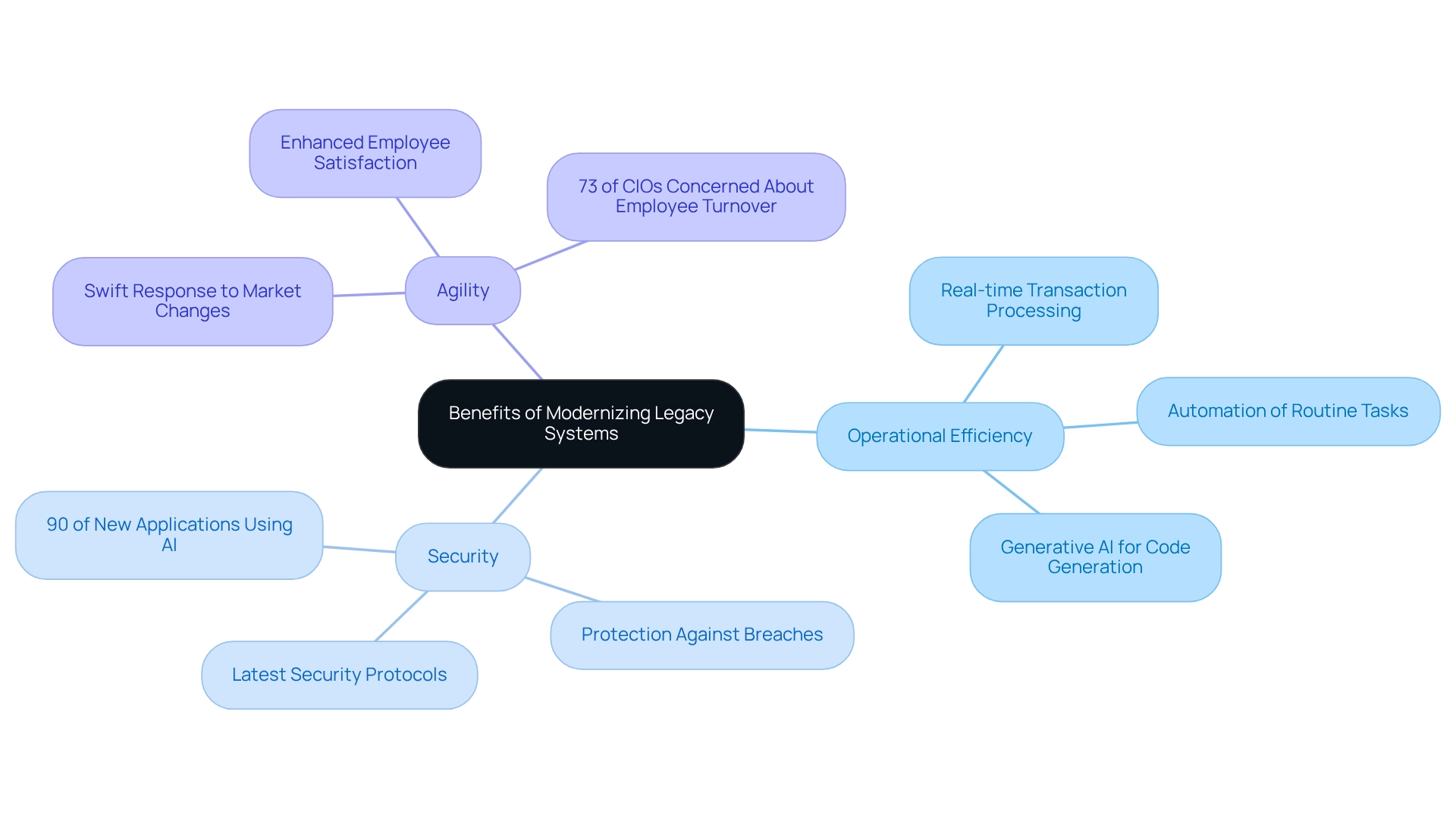Overview
Modernizing legacy systems is not just beneficial; it is essential for enhancing business efficiency, especially in sectors like banking. Outdated technologies hinder operational performance and inflate costs, leaving organizations vulnerable.
What challenges are your systems presenting?
- Legacy systems create data silos.
- Legacy systems pose security risks.
- Legacy systems lead to sluggish processing times.
This reality underscores our necessity to adopt modern solutions that improve integration, security, and agility. By embracing these advancements, we can streamline operations, reduce costs, and enhance overall performance.
We invite you to explore how transitioning to modern systems can transform your business landscape.
Introduction
In a world where technological advancements shape the future of business, we recognize that legacy systems represent a significant hurdle for many organizations, particularly in the banking sector. These outdated technologies, while still integral to our daily operations, can hinder efficiency, elevate costs, and expose us to security vulnerabilities.
As we embark on our digital transformation journeys, understanding the challenges posed by legacy systems becomes imperative. This article delves into the impact of these systems on our business operations, highlights the pressing need for modernization, and explores the myriad benefits that come with embracing contemporary technologies.
By examining effective strategies for transitioning away from legacy systems, we can not only mitigate risks but also position ourselves for sustainable growth in an increasingly competitive landscape.
Define Legacy Systems and Their Impact on Business Operations
Legacy frameworks represent outdated technologies, software, or hardware that persist within organizations, despite being outclassed by more advanced solutions. While these frameworks often underpin essential business operations, they can severely impede operational efficiency due to their inherent limitations. For example, a significant number of banking organizations still depend on antiquated infrastructures for transaction processing, resulting in sluggish response times and elevated operational costs.
The impact of these frameworks on business processes is profound; they foster data silos, restrict integration with modern technologies, and heighten security vulnerabilities. Indeed, by 2025, an astonishing 37% of businesses, particularly in the banking sector, are prioritizing the replacement of outdated technologies to enhance customer experience.
As we navigate the digital transformation journey, understanding why modernize legacy systems is crucial for recognizing the necessity for modernization and the myriad benefits that can result. Experts assert that ‘older platforms function as anchors,’ obstructing operational efficiency and innovation. Furthermore, case studies reveal that although traditional frameworks present challenges, they often harbor valuable patterns that can be adapted to contemporary technology stacks, transforming potential drawbacks into strategic advantages.
The financial burden of maintaining these obsolete infrastructures is substantial, with U.S. companies and government spending over $1.14 trillion annually on older technology maintenance, as highlighted in the case study ‘Economic Impact of Legacy System Maintenance.’ This financial pressure diverts resources from critical digital transformation initiatives, especially within the banking industry.
Therefore, understanding why modernize legacy systems is not merely about operational efficiency; it is a vital step toward fostering innovation and maintaining competitiveness in an ever-evolving digital landscape. Transitioning from conventional servers to virtualized infrastructures or cloud-based services can further propel this advancement effort.
Our dedicated hybrid integration platform plays a pivotal role in streamlining these disparate frameworks, enabling organizations to access isolated assets and enhance business value. By leveraging generative AI, we can revolutionize customer engagement and operational efficiency, ensuring our position at the forefront of the industry. The transformative potential of AI, as evidenced by the NVIDIA 2025 survey, underscores the urgency for banking IT managers to prioritize modernization strategies that integrate advanced technologies and drive significant business outcomes.
Identify Key Challenges of Legacy Systems: Costs, Security, and Performance
The significant challenges posed by outdated technologies illustrate why modernize legacy systems is essential for improving our organization’s efficiency and security, especially in the banking sector. The considerable financial burden of maintaining these obsolete infrastructures highlights why modernize legacy systems, as it often consumes a substantial portion of our IT budget and diverts resources away from innovation.
Security risks present an additional pressing concern, which highlights why modernize legacy systems is essential, as outdated infrastructures frequently lack the necessary updates and patches to protect against contemporary cyber threats, rendering them susceptible to breaches. For instance, in 2018, a major hotel conglomerate experienced a massive data breach due to vulnerabilities in its outdated reservation infrastructure, compromising the information of 500 million guests. This case underscores the critical need for robust security measures in today’s digital landscape.
The performance issues that arise highlight why modernize legacy systems, as these systems struggle to manage increased workloads and integrate with newer technologies, leading to sluggish processing times and diminished productivity. For example, a healthcare organization relying on outdated patient management systems may face significant delays in patient care due to inefficient data retrieval processes, ultimately impacting patient outcomes.
We ensure continuous availability for essential integrations, highlighting the performance advantages of contemporary solutions, which prompts the discussion on why modernize legacy systems, considering that the financial implications of sustaining older technologies extend beyond immediate costs. Organizations encounter hidden expenses associated with downtime and inefficiencies, highlighting why modernize legacy systems is essential, as these costs can accumulate over time.
As evidenced by customer testimonials, such as those from Tony LeBlanc of the Provincial Health Services Authority, companies that have transitioned to modern integration platforms like ours have reported not only enhanced operational capabilities but also substantial cost savings. We assist organizations in engaging stakeholders to accurately gather requirements from the outset and prepare their systems to integrate new tools with existing resources. This highlights the importance of directly addressing these legacy challenges, as we expedite the merging of isolated networks and fragmented data, which illustrates why modernize legacy systems is crucial for providing the integrated foundation businesses need to streamline, standardize, and modernize.
Explore the Benefits of Modernizing Legacy Systems: Efficiency, Security, and Agility
Updating traditional frameworks is essential for improving business efficiency, particularly in the banking industry, which raises the question of why modernize legacy systems. We recognize that a significant advantage lies in the enhancement of operational efficiency. Modern solutions, such as those provided by Avato’s Hybrid Integration Platform, are strategically designed to optimize processes, minimize manual interventions, and automate routine tasks. This transformation leads to quicker response times and optimized resource allocation. For instance, when a financial organization upgrades its transaction processing infrastructure, it can manage customer requests in real-time, resulting in heightened customer satisfaction and loyalty. Furthermore, our platform offers real-time observation and notifications on performance, ensuring that any issues are swiftly addressed, thereby further enhancing operational efficiency.
Security stands as another critical area where upgrades excel. By implementing the latest security protocols and ensuring regular updates, we can better protect sensitive information from breaches. Avato’s platform is architected for secure transactions, making it a trusted choice for banks, healthcare, and government sectors. This proactive approach to security is vital in an era where 90 percent of new enterprise applications are projected to leverage AI-powered technology by 2025. The integration of AI not only strengthens security protocols but also enables frameworks to adapt to emerging threats more effectively. Moreover, advancement fosters agility, allowing organizations to respond swiftly to market changes and evolving customer needs. This adaptability is crucial, especially as 73% of CIOs express concerns about employee turnover due to competitive talent markets. Updated frameworks can help retain talented staff by enhancing employee satisfaction through streamlined procedures and reduced workloads.
Integrating generative AI into modernization initiatives can further elevate operational efficiency. For example, it can dynamically generate code for infrastructure components, enhancing AIOps by analyzing alerts and logs, which leads to faster incident resolution and improved overall performance. Specific case studies illustrate that financial institutions employing generative AI have optimized their document processing and report generation, significantly boosting productivity across various departments. As Steve Hockey, CEO and Co-Founder of MyHub, emphasizes, innovation is vital for fostering stronger, more interconnected teams, particularly in the banking sector.
By transitioning to contemporary frameworks, we not only mitigate risks but also position ourselves for sustainable growth and a competitive edge in the future. In summary, understanding why modernize legacy systems is important highlights the benefits of updating outdated infrastructures, which include increased efficiency, enhanced security, greater agility, and substantial cost savings—factors that are crucial for thriving in today’s dynamic banking environment.

Outline Strategies for Effective Legacy System Modernization
Successful enhancement of the legacy framework necessitates a strategic plan that considers why modernize legacy systems, tailored to our organization’s unique needs. A comprehensive assessment of existing systems is essential to understand why modernize legacy systems, as it helps identify critical pain points and prioritize areas for improvement. We must consider various updating strategies, including rehosting, refactoring, or transitioning to cloud-based solutions, which raises the question of why modernize legacy systems. Involving stakeholders throughout the process is vital for aligning our improvement efforts with business goals, ensuring smoother transitions and greater support.
A phased modernization approach, often referred to as evolutionary modernization, illustrates why modernize legacy systems can significantly reduce disruptions. This multi-phased strategy demonstrates why modernize legacy systems is essential, enabling us to upgrade one system at a time while preserving operational continuity, thereby reducing risk and promoting a more manageable transition. Our hybrid integration platform supports this approach, allowing us to modernize effectively while leveraging existing infrastructure. Furthermore, investing in training and support for our staff is crucial, equipping them with the necessary skills to utilize new technologies effectively. Our expert integration services can assist in this training, ensuring that our teams are well-prepared for the transition.
Statistics indicate that organizations adopting updates demonstrate significant advantages, which raises the question of why modernize legacy systems, including improved security, scalability, and reliability. In fact, more than half of these entities have undergone substantial enhancements in these areas. Notably, a recent survey revealed a decrease in entities intending to buy back applications, falling from 20% in 2021 to 13% in 2023, highlighting why modernize legacy systems is becoming a priority instead of substituting.
As John Johnstone from OSME Pacific observed, “Avato has the capability to streamline intricate projects and provide outcomes within specified time limits and financial restrictions,” highlighting the success of our improvement initiatives. By adhering to these strategies and leveraging our global partnership services, we can adeptly navigate the complexities of modernization, illustrating why modernize legacy systems is essential for unlocking the full potential of our operations and achieving greater efficiency.
Conclusion
Legacy systems present a formidable challenge for organizations, particularly in the banking sector, where outdated technologies can impede efficiency, increase costs, and raise security concerns. We recognize the multifaceted impact of legacy systems on business operations, emphasizing the critical need for modernization. The financial burden of maintaining these systems diverts resources from essential innovation, while security vulnerabilities expose organizations to significant risks. Performance issues further exacerbate these challenges, highlighting the urgency for banks to transition away from these outdated infrastructures.
Modernizing legacy systems offers a plethora of benefits, including enhanced operational efficiency, improved security measures, and increased agility. By embracing contemporary solutions, we can streamline processes, protect sensitive data, and swiftly adapt to changing market demands. The integration of advanced technologies, such as generative AI, plays a pivotal role in this transformation, enabling us to optimize operations and foster innovation.
Implementing effective modernization strategies is essential for navigating the complexities associated with legacy systems. A phased approach, coupled with stakeholder engagement and staff training, ensures a smoother transition while maximizing the potential of new technologies. As we prioritize modernization, we not only mitigate risks but also position ourselves for sustainable growth and competitive advantage in an increasingly digital landscape.
In conclusion, addressing the challenges posed by legacy systems is not merely an operational necessity; it is a strategic imperative for organizations seeking to thrive in a dynamic environment. By committing to modernization efforts, we can unlock greater efficiency, security, and agility, ultimately paving the way for a more innovative and resilient future.

